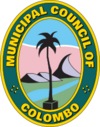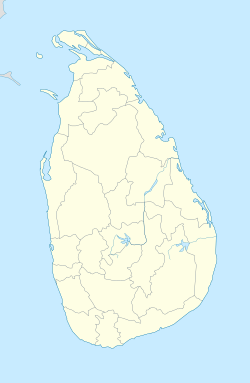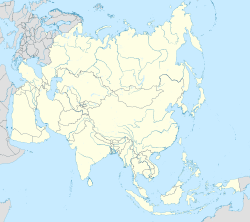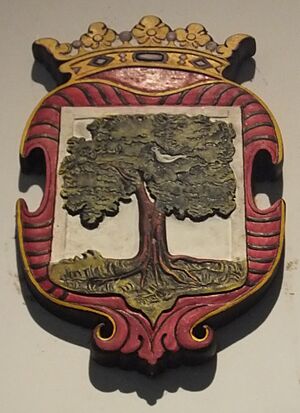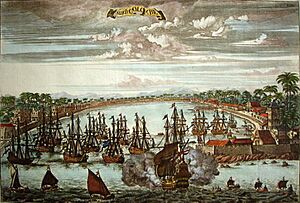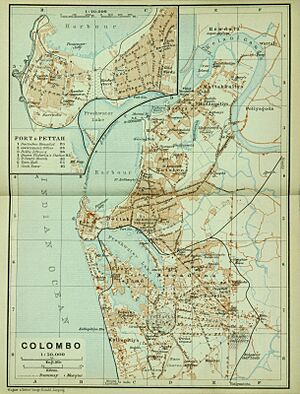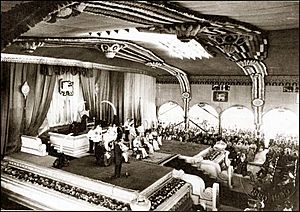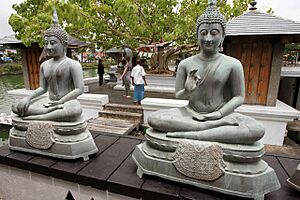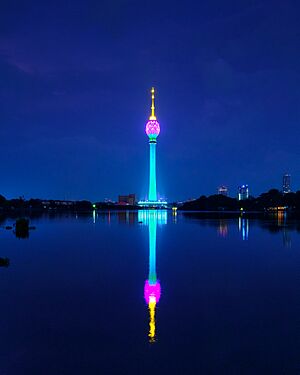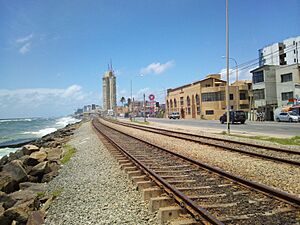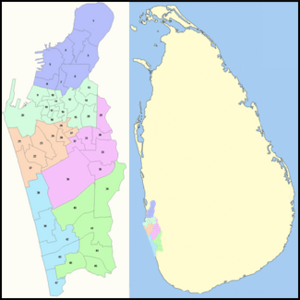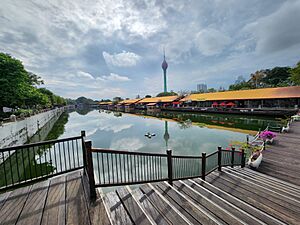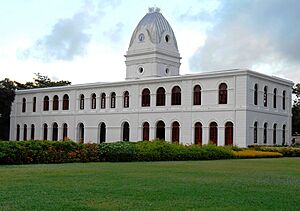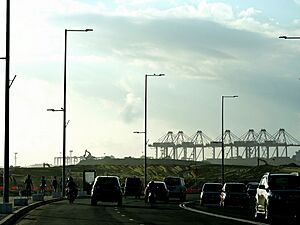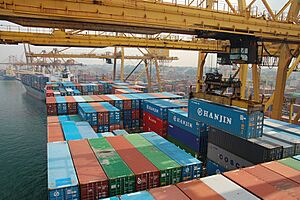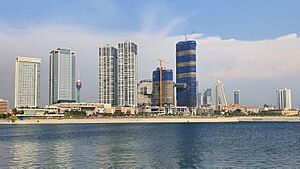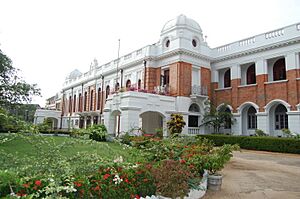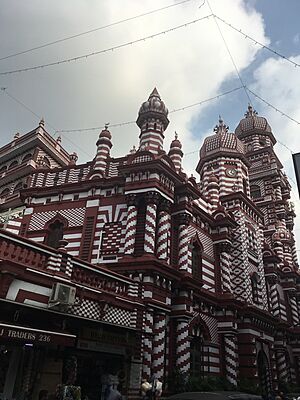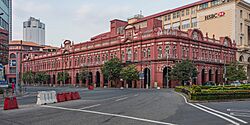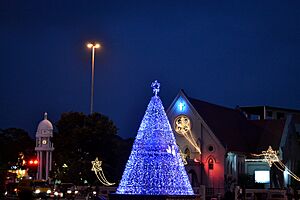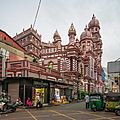Colombo facts for kids
Quick facts for kids
Colombo
කොළඹ
கொழும்பு |
|||
|---|---|---|---|
|
The Old Parliament Building, Bank of Ceylon building and WTC twin towers in the Colombo financial district of Fort
Buddha statues at Seema Malaka
Independence Memorial Hall
The Murugan Hindu temple in Company Roads
the Grand Oriental Hotel in Fort
Nelum Pokuna
Skyline over Galle Face Green (middle), with Shangri-La Hotel and One Galle Face (left), and Indian Ocean (right)
|
|||
|
|||
| Country | Sri Lanka | ||
| Province | Western Province | ||
| District | Colombo District | ||
| Area | |||
| • Capital city (executive and judicial) | 37.31 km2 (14.41 sq mi) | ||
| • Land | 699 km2 (270 sq mi) | ||
| • Metro | 3,684 km2 (1,422 sq mi) | ||
| Elevation | 1 m (3 ft) | ||
| Population
(2011)
|
|||
| • Capital city (executive and judicial) | 752,993 | ||
| • Density | 20,182/km2 (52,270/sq mi) | ||
| • Urban | 2,323,826 | ||
| • Metro | 5,648,000 | ||
| Time zone | UTC+05:30 (SLST) | ||
| Postal code |
0xxxx
|
||
| Area code(s) | 011 | ||
Colombo is the biggest city in Sri Lanka by population. It is the country's executive and judicial capital. It is also a major financial hub and a popular place for tourists.
Colombo is located on the west coast of Sri Lanka. It is part of a larger area called Greater Colombo. This area includes Sri Jayawardenepura Kotte, which is the legislative capital. People often call Colombo the capital because Sri Jayawardenepura Kotte is actually inside Colombo's urban area.
Colombo became the capital when Sri Lanka was given to the British Empire in 1815. It stayed the capital even after Sri Lanka became independent in 1948. In 1978, the main government offices moved to Sri Jayawardenepura Kotte. But Colombo was still named the commercial capital of Sri Lanka. Today, Colombo is a busy city with a mix of modern buildings, old colonial structures, and historical monuments.
Contents
What's in a Name?
The name 'Colombo' was first used by Portuguese explorers in 1505. Many believe it comes from the old Sinhala name Kolon thota. This means "port on the Kelani River".
Another idea is that the name comes from Kola-amba-thota. This means 'Harbour with leafy/green mango trees'. An old book from the 13th century also mentions the word kolamba. It means "fort or harbour" and might be where the name Colombo came from.
A Look Back in Time
The traveler Ibn Battuta visited Sri Lanka in the 1300s. He called the city Kalanpu. Arab traders started settling in Colombo around the 700s AD. The port helped their businesses a lot. They controlled much of the trade between the local kingdoms and the outside world.
Portuguese Rule
Portuguese explorers first arrived in Sri Lanka in 1505. They made a deal with the King of Kotte. This allowed them to trade in cinnamon, which grew along the coast, including in Colombo. The Portuguese were given control of the coastline. In return, they promised to protect it from invaders.
They set up a trading post in Colombo. Soon, they built a fort in 1517. The Portuguese realized they needed to control Sri Lanka to protect their bases in India. They used rivalries within the royal family to gain power. Eventually, they took over a large part of the Kotte kingdom.
The Sinhalese King Mayadunne started a new kingdom and fought back. He forced the Portuguese to stay in Colombo. They often needed help from their main base in Goa, India. After Mayadunne's kingdom fell in 1593, the Portuguese fully controlled the coastal area. Colombo became their capital.
Today, this part of Colombo is still called Fort. It has the presidential palace and many fancy hotels. The area just outside Fort is known as Pettah. It is a busy market and business area.
Dutch Rule
In 1638, the Dutch made a deal with King Rajasinha II of Kandy. They agreed to help him fight the Portuguese. In return, the Dutch would get control of the island's main trade goods. The Portuguese fought the Dutch and the Kandyans. But they slowly lost their strongholds.
The Dutch captured Colombo in 1656 after a long fight. Only 93 Portuguese soldiers survived. The Dutch then controlled the richest cinnamon lands, including Colombo. It served as the capital of the Dutch areas until 1796.
British Rule
The British took over Colombo in 1796. It was a military base until 1815. That year, the Kandyan Kingdom was given to them. The British then made Colombo the capital of their new colony, British Ceylon.
Unlike the Portuguese and Dutch, the British used Colombo for more than just a fort. They built houses and other buildings around the fort. This is how the modern City of Colombo began.
The British started a Municipal Council in 1865. This was to help local people learn to govern themselves. The Council met for the first time on January 16, 1866. At that time, about 80,000 people lived in the city. The British planned much of the city we see today. You can still see old tram tracks and granite roads from their time.
After Independence
Sri Lanka became independent from Britain in 1948. This changed the city and the country a lot. A new culture grew, mixing European styles with local customs. You can still see the influence of the Portuguese, Dutch, and British in Colombo's buildings, names, food, and language. Old buildings from all three periods remind us of Colombo's past.
Colombo used to mean the area around the Fort and Pettah Market. Today, it refers to the city limits of the Colombo Municipal Council. More often, the name means the larger area called Greater Colombo. This includes other towns like Kotte and Dehiwala-Mount Lavinia.
Even though Sri Jayawardanapura Kotte is now the official capital, Colombo is still the main business center. Most countries still have their diplomatic missions (embassies) in Colombo.
City Layout
Colombo has both land and water. The city has many canals. In the middle of the city is the Beira Lake, which is about 65 hectares (160 acres) big. This lake is a famous landmark. For centuries, colonists used it to protect the city. Today, it is a tourist spot. It hosts boat races and shows on its shores. The Kelani River forms the northern border of Colombo. It flows into the sea at a place called Modera.
Weather in Colombo
Colombo has a hot climate all year round. From March to April, the temperature is usually around 31°C (88°F). The biggest weather changes happen during the monsoon seasons. These are from April to June and September to November, when it rains a lot. Colombo gets about 2500 mm (98 inches) of rain each year. Even in the drier months, the temperature usually stays above 22°C (72°F).
Places to See
- Galle Face Green: This is a large open space along the Indian Ocean coast. It is popular with both tourists and locals. The historic Galle Face Hotel is right next to it.
- Gangaramaya Temple: This is one of the most important temples in Colombo. Its design mixes styles from Sri Lanka, Thailand, India, and China.
- Viharamahadevi Park: This is the oldest and largest park in Colombo. It is next to the National Museum of Colombo and the Town Hall. The park has a large statue of Buddha.
- New Public Spaces: The government has turned many old places into modern public areas. These include Independence Memorial Hall Square, Pettah Floating Market, and the Old Colombo Dutch Hospital.
People of Colombo
Ethnicity in Colombo Municipality area (2012) Sinhalese (36.9%) Sri Lankan Tamils (29.6%) Sri Lankan Moors (29.0%) Indian Tamils (2.2%) Others (5%)
Colombo is a city with many different religions and cultures. Its population is a mix of different groups, mainly Sinhalese, Sri Lankan Moors, and Sri Lankan Tamils. There are also smaller groups of people from Chinese, Portuguese, Dutch, Malay, and Indian backgrounds. Many Europeans live in the city too. Colombo is the most populated city in Sri Lanka, with over 642,000 people living within its city limits. In 1866, the city had about 80,000 people.
Religion in Colombo Municipality area (2012) Buddhism (31.4%) Islam (31.2%) Hinduism (22.6%) Christianity (14.5%) Other (0.1%)
City Areas
Colombo is divided into 15 areas for postal services. Each area has its own suburbs and post office. For example, Colombo 1 is the Fort area, and Colombo 4 is Bambalapitiya.
Economy and Business
Most of Sri Lanka's big companies have their main offices in Colombo. These include companies that make chemicals, textiles, glass, and jewelry. The World Trade Centre is in the city center. It has two tall towers and is a major business hub in the Fort district.
The Colombo area is very important for Sri Lanka's economy. It creates about 40% of the country's total economic output. This makes it one of the richest regions in South Asia. A lot of the country's goods for export are made in the Colombo area. The government wants to make Colombo an even more important international city.
The Pettah area is very busy and crowded. Its streets are full of small shops selling everything from drinks to clothes. Many of these businesses are run by Muslim traders. Sea Street, which is Sri Lanka's gold market, is mostly run by Tamil businesses.
City Services
Colombo has most of the services a modern city needs. It has good electricity, water, and transport systems. There are also many luxury hotels, clubs, and restaurants. Recently, many tall apartment buildings have been built because land prices are very high.
Harbour
The Colombo Harbour is the largest and busiest port in Sri Lanka. It was built as a port city during the colonial times. The harbour has been made bigger over the years. The Sri Lanka Navy has a naval base there.
The Port of Colombo handles millions of shipping containers each year. It is one of the busiest ports in the world. It is also considered the busiest and largest port in the Indian Ocean. Colombo is part of the "21st Century Maritime Silk Road," a big trade route.
Getting Around
Buses
Colombo has a large public transport system with buses. Both private companies and the government run these buses. The main bus stations are in Pettah. Some buses go long distances, while others serve local areas.
Trains
Train travel within the city is limited. Most trains are for traveling to and from Colombo, and they can be very crowded. The Fort Railway Station is the main train hub for the whole island.
- Main Line: Connects Colombo Fort to places like Kandy, Badulla, and Jaffna.
- Coastal Line: Goes from Colombo to southern cities like Galle and Matara.
- Puttalam Line: Connects Colombo to Negombo and Puttalam.
- Kelani Valley Line: Goes from Colombo to Avissawella.
Other ways to get around include auto rickshaws (called "three-wheelers") and taxicabs. Three-wheelers are run by individuals, while taxis are run by companies and use meters.
Roads
After the war, many new highways were built around Colombo. The Southern Expressway connects Colombo to Matara in the south. The Colombo–Katunayake Expressway links Colombo to the Colombo International Airport and the city of Negombo. There is also the Outer Circular Highway, which is a bypass around Colombo.
Major highways connecting Colombo to other cities:
- A1 highway to Kandy.
- A2 highway to Galle and Matara.
- A3 highway to Negombo and Puttalam.
- A4 highway to Ratnapura and Batticaloa.
Ferries
A ferry service connects Colombo to Tuticorin, India. This service was restarted after more than 20 years.
Air Travel
Ratmalana Airport is Colombo's airport. It is about 15 km (9 miles) south of the city center. It opened in 1935 and was Sri Lanka's first international airport. In 1967, Bandaranaike Airport took over as the main international airport. Now, Ratmalana Airport mainly handles local flights and corporate flights.
Famous Buildings
The two World Trade Centre towers are well-known landmarks. Before they were built in 1997, the Bank of Ceylon tower was the tallest building. Even before that, the Old Parliament Building and the Old Colombo Lighthouse were the tallest. Another important landmark is the Independence Hall at Independence Square.
St. Paul's Church Milagiriya is one of the oldest churches in Sri Lanka. It was first built by the Portuguese and rebuilt by the British in 1848. The Cargills & Millers building in Fort is also a historic building.
Old cannons from the fort are now on display at the Green. The colonial-style Galle Face Hotel is next to Galle Face Green. It has hosted many famous guests, including the British Royal Family.
Learning in Colombo
Colombo has many important public schools, both government-owned and private. Many of these schools were started in the 1800s during British rule. For example, Royal College Colombo was founded in 1835. Some schools are linked to religions, like Christian missionary schools. These include Bishop's College (Anglican), Wesley College Colombo (Methodist), Ananda College (Buddhist), Zahira College (Muslim), and St. Joseph's College (Catholic). Their religious links do not change what they teach, only who attends. Colombo also has many International Schools.
Higher education has a long history in Colombo. The Colombo Medical School opened in 1870, and the Colombo Law College in 1875. The University College Colombo was set up in 1913. Today, the University of Colombo and the University of the Visual & Performing Arts are state universities in the city. There are also several private colleges.
City Design
Colombo's buildings show many different styles from over centuries. You can see colonial buildings from Portuguese, Dutch, and British times. These stand next to buildings with Buddhist, Hindu, Islamic, and modern designs. This mix is very clear in the Fort area. Here, new tall skyscrapers are right next to historic buildings from the 1700s.
Colombo Fort
The Portuguese were the first to settle in Colombo. They built a small trading post that grew into the island's largest colonial fort. The Dutch made the fort even stronger. The British took it over in the late 1700s. By the late 1800s, they started tearing down the fort walls to build up the city. Even though the walls are gone, the area is still called Fort. The area outside is called Pettah, Sri Lanka or Pitakotuwa in Sinhala, meaning "outer fort."

Dutch Buildings
There are no buildings left from the Portuguese era. But a few remain from the Dutch period. These include the former Dutch Hospital and the Dutch House, which is now the Colombo Dutch Museum. The President's House was originally the Dutch governor's home. It has changed a lot since then.
British Buildings
Many old buildings in Colombo are from British times. These include government offices, business buildings, and private homes. Some famous British colonial buildings are the old Parliament building (now the Presidential Secretariat) and the Republic Building. The General Post Office is an old building near the President's House.
Important business buildings from the British era include the Galle Face Hotel, the Cargills and Millers' complex, and the Grand Oriental Hotel.
Culture and Fun
Yearly Events
Colombo's most popular festival is Vesak. This celebrates the birth, enlightenment, and death of Buddha. It happens in mid-May and lasts a week. The city is decorated with lanterns and special light displays called thoran. Many Sri Lankans come to see the decorations. During this week, people give out free food and drinks at places called dunsal.
Since many Muslims live in Colombo, Eid Ul Fitr and Eid Ul Adha are also celebrated. The city gets very busy before Eid Ul Fitr as people do their last-minute shopping.
Christmas is another big festival. Even though Christians are a smaller part of Sri Lanka's population, Christmas is a major holiday. Streets and buildings light up in December. Shops have special sales, and you can often hear carols.
The Sinhalese and Hindu New Year, called Aluth Awurudda, is a cultural event on April 13 and 14. It includes many traditions that show Sri Lankan culture.
Arts and Shows
Colombo has several places for performing arts. These are popular for music and theater shows. The Lionel Wendt Theatre, the Elphinstone, and Tower Hall are used for Western-style shows. The Navarangahala is the country's first national theater built for Asian and local shows.
The Nelum Pokuna Mahinda Rajapaksa Theatre is a world-class theater that opened in 2011. Its design looks like the Lotus Pond in Polonnaruwa. It is a major place for theater.
Museums and Art
The National Museum of Colombo opened in 1877. It is in the Cinnamon Gardens area. The museum has the crown jewels and throne of the last king of Kandy.
The Colombo Dutch Museum tells the story of the Dutch colonial past. Colombo does not have a very big art gallery. There is a small collection of Sri Lankan paintings at the Art Gallery in Green Path. Next to it is the Natural History Museum.
Sports
cricket is one of the most popular sports in Sri Lanka. The country won the 1996 Cricket World Cup. Colombo has two major international cricket stadiums: Singhalese Sports Club's Cricket Stadium and R. Premadasa Stadium. The Colombo Stars team represents the city in the Lanka Premier League.
Colombo is unique because it used to have four cricket test venues. The Sugathadasa Stadium is an international stadium for athletics, swimming, and football. It hosted the South Asian Games in 1991 and 2006. The Royal Colombo Golf Club is one of the oldest in Asia. Other sports clubs include the Colombo Swimming Club and the Colombo Rowing Club.
Rugby is also popular in schools and clubs. Colombo has its own football team, Colombo FC. The Colombo Port City plans to build a new Formula One track near the harbour. This track could host the Sri Lankan Grand Prix. The Colombo Marathon is an internationally recognized race that started in 1998.
Media
Almost all major media companies in Sri Lanka are in Colombo. The state-owned media, like the Sri Lanka Broadcasting Corporation (SLBC) and the Sri Lanka Rupavahini Corporation, have their offices here. The SLBC is the oldest radio station in South Asia. Many private radio and TV stations also operate in Colombo.
Sister Cities
| Country | City | Since |
|---|---|---|
| Nepal | Biratnagar | 1874 |
| Russia | Saint Petersburg | 1997 |
| China | Shanghai | 2003 |
| United Kingdom | Leeds | 2008 |
| Mongolia | Ulaanbaatar | 2012 |
| Maldives | Malé | 2013 |
| Maldives | Maroshi | 2015 |
Images for kids
-
The Town Hall of Colombo at night, it is the headquarters of the Colombo Municipal Council and the office of the Mayor of Colombo
-
St. Lucia's Cathedral, the seat of the Archbishop of the Roman Catholic Archdiocese of Colombo
See also
 In Spanish: Colombo para niños
In Spanish: Colombo para niños










